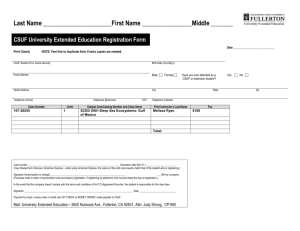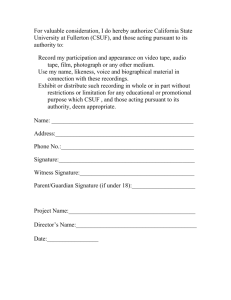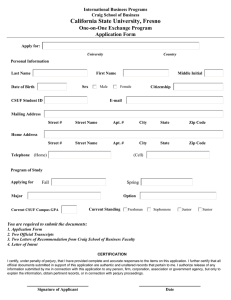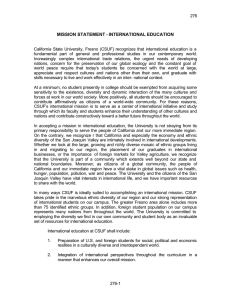Archived GAUSS 2013/14
advertisement
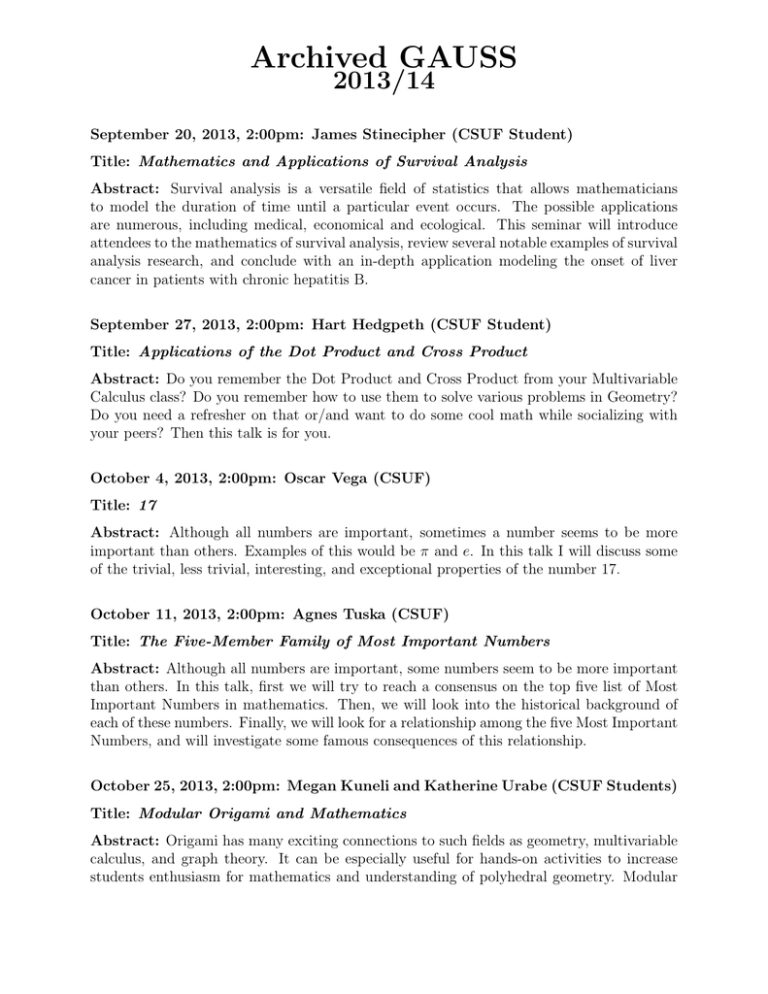
Archived GAUSS 2013/14 September 20, 2013, 2:00pm: James Stinecipher (CSUF Student) Title: Mathematics and Applications of Survival Analysis Abstract: Survival analysis is a versatile field of statistics that allows mathematicians to model the duration of time until a particular event occurs. The possible applications are numerous, including medical, economical and ecological. This seminar will introduce attendees to the mathematics of survival analysis, review several notable examples of survival analysis research, and conclude with an in-depth application modeling the onset of liver cancer in patients with chronic hepatitis B. September 27, 2013, 2:00pm: Hart Hedgpeth (CSUF Student) Title: Applications of the Dot Product and Cross Product Abstract: Do you remember the Dot Product and Cross Product from your Multivariable Calculus class? Do you remember how to use them to solve various problems in Geometry? Do you need a refresher on that or/and want to do some cool math while socializing with your peers? Then this talk is for you. October 4, 2013, 2:00pm: Oscar Vega (CSUF) Title: 17 Abstract: Although all numbers are important, sometimes a number seems to be more important than others. Examples of this would be π and e. In this talk I will discuss some of the trivial, less trivial, interesting, and exceptional properties of the number 17. October 11, 2013, 2:00pm: Agnes Tuska (CSUF) Title: The Five-Member Family of Most Important Numbers Abstract: Although all numbers are important, some numbers seem to be more important than others. In this talk, first we will try to reach a consensus on the top five list of Most Important Numbers in mathematics. Then, we will look into the historical background of each of these numbers. Finally, we will look for a relationship among the five Most Important Numbers, and will investigate some famous consequences of this relationship. October 25, 2013, 2:00pm: Megan Kuneli and Katherine Urabe (CSUF Students) Title: Modular Origami and Mathematics Abstract: Origami has many exciting connections to such fields as geometry, multivariable calculus, and graph theory. It can be especially useful for hands-on activities to increase students enthusiasm for mathematics and understanding of polyhedral geometry. Modular origami involves many small squares of paper folded into identical units, then locked together to form a variety of shapes. In this talk we will fold a modular star ring, then use geometry to prove its ideal number of units. November 1, 2013, 2:00pm: Elaina Aceves and Jennifer Elder (CSUF Students) Title: Jump Ropes and Arithmetic: Conway’s Rational Tangles Abstract: Do you ever get your headphones tangled while they are in your pocket? Do you want to explore how to untangle them mathematically? In this hands-on activity, we will use jump ropes to construct tangles and then learn how to untangle them with the fewest number of moves. We will be labeling each tangle with a number and then using some basic arithmetic to find out what moves are necessary to untangle it. This activity is perfect for engaging high school students in fun and interesting mathematics. November 8, 2013, 2:00pm: Doreen De Leon (CSUF) Title: Using Operators to Solve Differential Equations Abstract: The differential operator D is a linear operator defined by D(f ) = f 0 . Differential operators may be used to solve homogeneous constant coefficient differential equations, as well as certain non-homogeneous equations. November 13, 2013, 2:00pm: Kelsey Friesen, Hilary Heinrich, and Thoa Tran (CSUF Students) Title: Deriving Approximations of π Abstract: This presentation seeks to engage the participants in a method for approximating the value of π, using only high school geometry. This activity is ideal for prospective high school math teachers, and any math enthusiasts. November 22, 2013, 2:00pm: Elda Bautista (CSUF Student) Title: Jacobi and Gauss-Seidel Methods Abstract: Solving a system of equations with a square 5 x 5 coefficient matrix using direct methods, such as the Gauss-Jordan method, can be a challenge for some students. However, these direct methods give the exact solution of the system. Can you imagine solving a system with a 5000 x 5000 coefficient matrix using direct methods? You might think the tool to be used is a computer, and you would be right. However, computers many times will not give the exact solution due to rounding errors. There is another class of methods for solving linear systems, the iterative methods. These methods yield to an approximate solution that converges to the exact solution of the system within some tolerance. We will explain two basic iterative methods, Jacobi and Gauss-Seidel methods, and then we will do some examples using these methods. December 6, 2013, 2:00pm: David Heywood (CSUF Student) Title: Generating Functions Abstract: Generating functions appear in various areas of mathematics, such as number theory, statistics, and complex analysis. In this talk, we consider some of the uses of generating functions as they apply to combinatorics. In particular, we discuss how generating functions may be employed to find closed formulae for recurrence relations, and to solve certain types of counting problems. February 14, 2014 at 3:30pm: Hilary Heinrich (CSUF Student) Title: Workshop: Introduction to GeoGebra Abstract: GeoGebra is an open-source mathematics software that allows the development of dynamic worksheets and mathematical investigations from elementary school through university level. It is an interactive, geometry, algebra, statistics, and calculus application, intended for teachers and students. February 21, 2014 at 3:00pm: Manuel Lopez (CSUF Student) Title: Random Walks Abstract: A random walk is a mathematical formalization of a path that consists of a succession of random steps. Random walks are used to model stochastic behaviors in diverse fields of study such as ecology, economics, finance, physics, and psychology. In this talk, we will explore and develop a simple random walk model that will be useful in explaining various natural phenomena. March 28, 2014; 3:30pm: Elaina Aceves and Jennifer Elder (CSUF Students) Title: Young Tableaux Abstract: Young tableaux are combinatorial objects introduced by Alfred Young in 1900, and have numerous applications, not only in combinatorics but also in other areas in mathematics. In particular, Young tableaux are intimately related to the symmetric and general linear groups. A Young diagram of a partition n = a + b + . . . + c, for a list a, b, . . . , c of k positive integers with a ≥ b ≥ . . . ≥ c is an arrangement of n square boxes in k rows, such that the boxes are left-justified, the first row is of length a, the second row of length b, and so on, with the k-th row of length c. A Young tableau of a Young diagram is obtained by placing the numbers 1, . . . , n in the n boxes of the diagram. The partitions of integers less than or equal to mn in which there are at most n parts and in which no part is larger than m correspond to Young tableaux which fit inside an m × n rectangle, and to lattice paths which travel from the upper right corner of the rectangle to the lower left corner in m + n leftward and downward steps. What is the number of Young diagrams fitting inside an m × n rectangle? This talk is a gentle introduction to Young tableaux and some of their properties. April 25, 2014; 3:00pm: Megan Kuneli and Katherine Urabe (CSUF Students) Title: Fractals and Iterated Function Systems Abstract: Fractals are objects that display self-similar patterns. Due to their prevalence in nature and beautiful visualizations, they provide an accessible way to introduce the general public to mathematical concepts. In this presentation we explore different types of transformations and their effects. We use these transformations to make iterated function systems, mappings that generate fractals. In particular, we demonstrate using iterated function systems how to create famous fractals, such as the Cantor set and the Sierpinski triangle.
